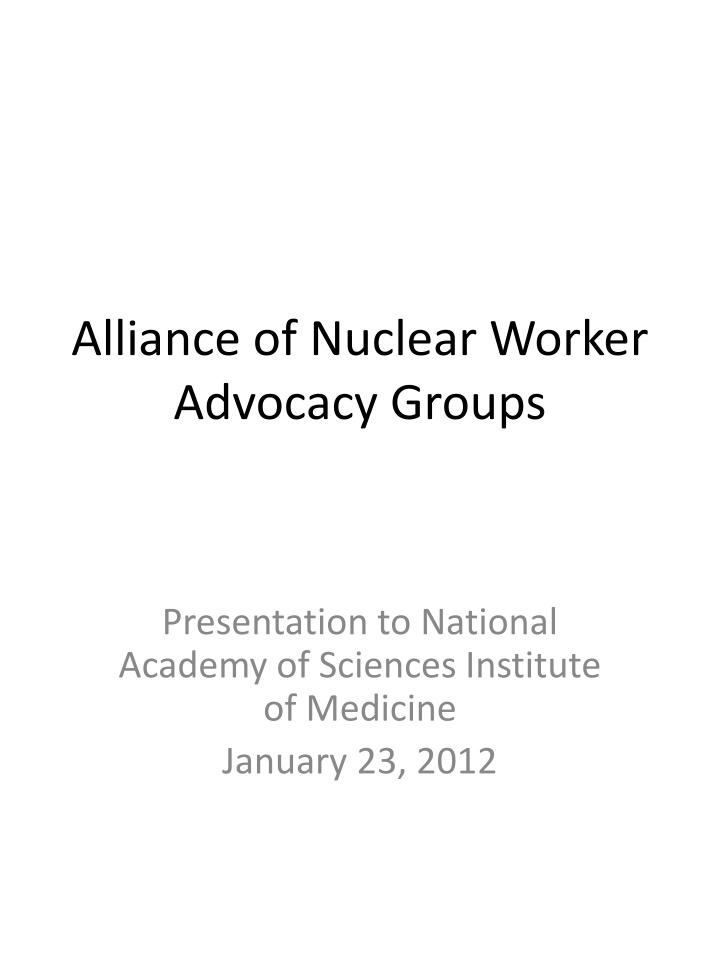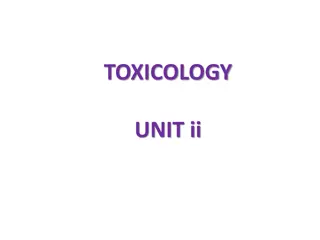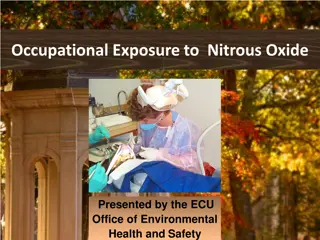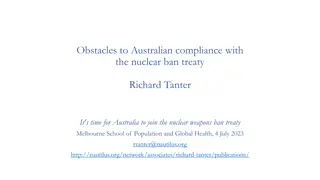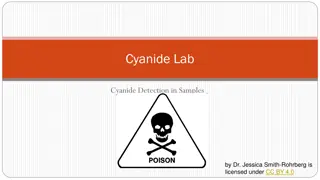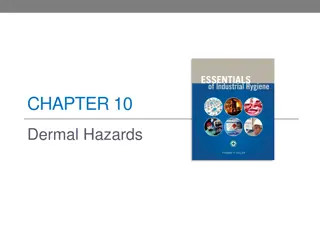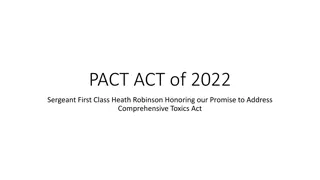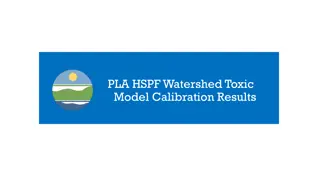Alliance of Nuclear Worker Advocacy Groups Presentation on Toxic Substances Exposure
Presentation by Alliance of Nuclear Worker Advocacy Groups addressing the need to develop a matrix of toxic substances and related diseases to facilitate timely compensation for DOE workers. Emphasizes the importance of thorough documentation and recognition of exposure risks. Discusses applicable laws and guidelines for determining covered illnesses due to toxic substance exposure at DOE facilities.
Download Presentation

Please find below an Image/Link to download the presentation.
The content on the website is provided AS IS for your information and personal use only. It may not be sold, licensed, or shared on other websites without obtaining consent from the author.If you encounter any issues during the download, it is possible that the publisher has removed the file from their server.
You are allowed to download the files provided on this website for personal or commercial use, subject to the condition that they are used lawfully. All files are the property of their respective owners.
The content on the website is provided AS IS for your information and personal use only. It may not be sold, licensed, or shared on other websites without obtaining consent from the author.
E N D
Presentation Transcript
Alliance of Nuclear Worker Advocacy Groups Presentation to National Academy of Sciences Institute of Medicine January 23, 2012
ANWAGS COMMENT ON INTERIM FINAL RULES Develop a matrix of toxic substances (DOE workers were known to have had exposures to) and all the diseases and /or conditions these toxins were known to aggravate, contribute to or cause. Verification of these toxic substances on site should be developed through the occupational histories already submitted by claimants or by DOE's contribution to the claim, or by other means such as purchase orders for these toxins, DOE Tiger Team Reports , and DOE Independent Investigation Health and Safety Reports, all other federal and state monitoring agencies. A disease list should use the MSDS of each toxic substance, medical literature, federal monitoring agency reports and any other credible source of information. If an agency or credible medical study shows that a toxic exposure aggravated, contributed to or caused a disease it needs to be listed in the matrix. Waiting for a consensus between agencies or the medical community will conflict with Congressional intent for timely compensation. Each toxic substance should be listed with the maximum exposure effects, as monitoring these substances was either limited or non-existent. Many of these substances have since been banned from the work place, due to their dangerous health effects. MSDS recommendations were not always followed. For example, TCE (trichloroethylene), now banned was recommended as a coolant for machine tooling and diluted according to MSDS. However, it was often used undiluted to degrease parts. Consequently, assuming maximum concentration will be claimant friendly. EEOICPA has adopted the policy that each worker at a facility where beryllium was present had the potential of exposure because of dust, vapor or liquid dispersion. This policy was developed because office workers, etc. have been diagnosed with Chronic Beryllium Disease, in addition to the trades that worked with the metal. It has therefore been assumed that winds and water supplies as well as workers carrying the beryllium on the clothes and in their hair exposed the entire facility. The same policy should be used to assume that all workers had the potential exposure to other toxins. Anything less than an all inclusive matrix applied by well trained claims examiners familiar with using such a matrix would not comply with the Department of Labor s intent for this to be a claimant-friendly program.
What the law says 7385s-4. Determinations regarding contraction of covered illnesses (c) OTHER CASES. (1) In any other case, a Department of Energy contractor employee shall be determined for purposes of this part to have contracted a covered illness through exposure at a Department of Energy facility if (A) it is at least as likely as not that exposure to a toxic substance at a Department of Energy facility was a significant factor in aggravating, contributing to, or causing the illness; and (B) it is at least as likely as not that the exposure to such toxic substance was related to employment at a Department of Energy facility.
http://www.sem.dol.gov/Dis.cfm Stomach cancer (also known as Cancer of stomach; Gastric cancer; Gastric neoplasms) Toxic substances with an established causal link to the diagnosed illness as accepted by NLM (Note: EEOICPA evaluates toxic substance exposure that was a significant factor in aggravating or contributing to employee illness or death and is done on a case-by-case basis.): No toxic substances in the SEM database show an established causal link to the selected occupational disease at this time.
http://www.atsdr.cdc.gov/COM/cancer-fs.html Human Carcinogenic Agent Organ Known Suspected Arsenic Asbestos Benzo(a)pyrene bis(Chloromethyl) ether Chromium Nickel subsulfide Zinc chromate Tobacco smoking Mustard gas Uranium Acrylonitrile Beryllium Cadmium 1,2-Dibromo-3- chloropropane Polyclic aromatic hydrocarbons (PAHs) Lung Coke oven emissions Zinc chromate Tetrachloroethyle ne Kidney Benzidine Tetrachloroethyle ne Cyclophosphamid e 4-Aminodiphenyl Tobacco smoking Chloraphazine Tetrachloroethyle ne Bladder Zinc chromate Ethylene oxide Stomach Arsenic Benzo(a)pyrene Overexposure to the sun PAHs Tetrachloroethyle ne Skin Vinyl chloride Aflatoxin Alcoholic drinks Liver Alcoholic drinks Tobacco smoking Tobacco chewing (mouth only) Mustard gas (larynx) Mouth, pharynx, larynx, esophagus Prostate Cadmium
http://monographs.iarc.fr/ENG/Monographs/vol87/mono87-7.pdf Inorganic and organic lead compounds 2.1.3 Lead chromate pigment production Workers producing lead chromate pigments have been the subject of two cohort studies focused on possible lung carcinogenicity resulting from exposure to hexavalent chromium, which was classified as Group 1 human carcinogen by IARC (IARC, 1990). [It is not possible to separate the effects of chromium on the lung from those of lead in these studies, limiting their usefulness in the evaluation of the carcinogenicity of lead.] Sheffet et al. (1982) studied mortality among 1296 white and 650 non-white men in a pigment plant producing lead and zinc chromates in the USA who were employed for at least 1 month between 1940 and 1969, and followed through 31 March 1979. Moderate exposure was defined as work in jobs with an average exposure of 0.5 2 mg/m3 airborne chromium, while high exposure was defined as > 2 mg/m3 airborne chromium; 76% of the cohort had high or moderate exposure. A statistically significant relative risk of 1.6 (95% CI, 1.1 2.2; 31 deaths) for lung cancer was found among male employees, increasing to a significant 1.9 for those exposed for at least 2 years to moderate or high exposure. Stomach cancer had a SMR of 2.0 (95% CI, 0.9 3.6; 8 deaths). SMRs varied depending on whether or not those decedents with cause of death unknown (15%) were excluded from the observed count of lung cancers or added in proportion corresponding to the distribution of observed deaths with known causes. [SMRs for other cancers were calculated, but numbers were small and there were no significant findings.]
Cancer Mortality in pigment plant utilizing lead and zinc chromates 1982 Jan-Feb;37(1):44-52. Several studies of workers exposed to various forms of chromium compounds have suggested an increased incidence of respiratory cancers. Lead and zinc chromates were among the chromium compounds implicated. The Department of Preventive Medicine and Community Health of the New Jersey Medical School undertook a detailed mortality study of a pigment plant in Newark which utilized both of these compounds. We compared observed deaths from each cause among 1296 white and 650 non-white males who were employed at the plant between January 1, 1940 and December 31, 1969, with expected deaths, as computed from cause-, age-, and time-specific standard death rates for the United States. A statistically significant relative risk of 1.6 for lung cancer among white male employees was found, as well as among the cohorts of white males employed 10 yr or more. A relative risk of 1.9 was noted for individuals employed at least 2 yr who were at least moderately exposed to chromates. An increased incidence of lung cancer among non-white males and stomach and pancreatic cancer among the total cohort was also evident
Why Haz-Map is inappropriate to use for EEOICPA 1 - For a toxicologist Haz-Map has no value. Animal studies are not considered. 2 - For an epidemiologist Haz-Map has no value. It is too selective (only depends on causation), not sensitive enough to contributing or aggravating a disease. 3 - For an evidence-based review Haz-map does not follow the established rules of weighing evidence as outlined by IOM, https://download.nap.edu/catalog.php?record_id=13059; there is no protocol, no peer review, no grading of evidence or grading of conclusion 4 - For an occupational physician Haz-Map does not include combinations of chemical exposure, nor does it consider the pre- existing risk of exposure to ionizing radiation or pre-existing medical conditions. 5 For the program Haz-Map disposes of too many cases that may have merit because only an expert can judge merit of these very complex cases.
